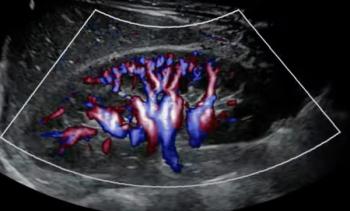
High-field MR imaging ensures clarity in kidneys and heart
Two investigative studies have found that MR angiography at 3T produces quality images of the kidneys and excellent cardiac cine images. Researchers used high parallel imaging factors and a 32-element phased-array coil to increase spatial resolution and anatomic coverage.
Two investigative studies have found that MR angiography at 3T produces quality images of the kidneys and excellent cardiac cine images. Researchers used high parallel imaging factors and a 32-element phased-array coil to increase spatial resolution and anatomic coverage.
Radiologist Dr. Michael Fenchel and colleagues from Eberhard-Karls University in Tuebingen, Germany, examined 11 healthy volunteers with a 3T Magnetom Trio scanner from Siemens Medical Solutions. The researchers also used a prototype 32-element phased-array coil from Invivo (Invest Radiol 2006:41[9]:697-703).
Contrast-enhanced 3D MRA images were acquired with integrated generalized autocalibrating partially parallel acquisition (GRAPPA), in both phase- and slice-encoding direction. Images were assessed by two independent observers with regard to image quality, noise, and presence of artifacts.
Investigators recorded signal to noise levels of 22.2 and 57.9 with and without parallel imaging, respectively. They found high image quality in nine of 11 volunteers with good overall interobserver agreement (k = 0.87). Relatively low image quality with higher noise levels was encountered in two volunteers.
In another study, the same team found that cardiac cine imaging at 3T using the 32-element body-array coil also is feasible. They concluded that using a large number of coil elements with a favorable sensitivity profile supports faster image acquisition, with high diagnostic image quality even for high parallel imaging factors (Invest Radiol 2006;41[8]:601-608).
Fenchel and colleagues tested the 3T 32-element phased-array coil protocol on eight healthy volunteers. Images were acquired in short-axis and four-chamber view. Reference images with identical scan parameters were acquired using the total imaging matrix (Tim) coil system with a total of 12 coil elements. Two observers assessed the images.
In phantom measurements, signal to noise values were increased by 115% to 155% for the various cine sequences using the 32-element coil. In volunteers, image quality and noise were statistically better using the 32-element coil.
Newsletter
Stay at the forefront of radiology with the Diagnostic Imaging newsletter, delivering the latest news, clinical insights, and imaging advancements for today’s radiologists.




























